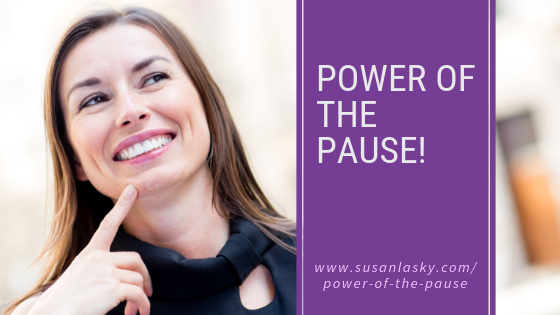Press ‘Pause’ to Review and Reset
If we’re always in action – or inaction, without taking a conscious pause to step back, observe, reflect and perhaps redirect, we’re doing ourselves an injustice. All pauses are not the same. Check these out:
PLANNING Pause – I often talk about Planning Time vs. Doing Time – how important it is to set aside specific time to focus on deciding what you need to do and how you’ll get it done (Clarity) along with when you’ll do it (Priority). When you pause to plan, your efficiency quota can increase exponentially! See my blog “The Two Magic Words for Productivity: Clarity and Priority.”
REFLECTION Pause – Another helpful distinction is Reflection Time vs. Action Time. The idea here is to make the time, while working on a project (preferably one task at a time!), to pause and think about the efficacy of your actions. Ask yourself if what you are doing now (task, project, direction, etc.) is the best thing for you to be doing at this point in time. Consciously consider whether your actions will help you to finish the project, attain a goal or, on a broader scale, live a life you love! If so, continue; if not, redirect your efforts.
HABIT Pause – One of the benefits of Reflection Time is seeing patterns you might have overlooked, or known but ignored. You can’t fix what you don’t realize is broken, so take a pause to think about it. Members of my online Action/Accountability group, The TUIT Project, are asked to consider not just what they’ve accomplished, but what worked and what got in the way. How can you build on that? What habits/patterns support your efforts, and which ones hold you back? Here’s an example: Annie is a TUIT group member who identified chronic perfectionism as getting in the way of her productivity. While helpful to a certain extent (especially knowing how easy it is to get distracted and careless), it’s also easy to have too much of an otherwise helpful thing – ever hear of ‘paralysis by analysis, or ruin something that was working by overthinking or over correcting, or miss a deadline because you wanted to fix ‘one more thing’? Awareness helps, and awareness begins with a pause.
DOING Pause: Redirect – I don’t believe you can just stop doing – or thinking – about something. There will be a void and you have to fill that void with a different ‘something.’ So, telling yourself to be less of a perfectionist is not going to be very helpful unless you then substitute another concept or behavior. In Annie’s case, an internal bell now rings when she’s caught up in perfectionism, and she reminds herself, “Go with Good ‘Nough!” as a replacement mantra for perfectionistic behavior. Successful people don’t constantly second guess themselves – they get into action and move forward towards completion, pushing through the obstacles instead of getting stuck in finding a perfect solution. See my blog “Ready – Fire – Aim.”
ACTION Pause – Sometimes, an Action Pause is the best way to get something done. Temporarily walk away from it – avoids the law of diminishing returns. Shift to another task or recharge with exercise, an outdoor break, play break or even a quick nap.
PROCESSING Pause – Many people with ADHD also have a degree of ‘slow processing.’ This has nothing to do with intelligence, nor the ability to understand concepts (which we often get quicker than many people). It does, I think, reflect the way many of us understand things. We need to relate new information to something we’ve already processed, whether consciously or not. Facts in a vacuum don’t work. So it may take a bit of time to absorb the new info and tie it together with something we already have stored in our atypical brain. That is partially our genius – we make links that many others will not. It’s also our challenge, because we may not easily get stuff that others pick up without pause. Allow yourself the gift of the pause. Take time, without guilt, to absorb things, whether it’s a conversation, a lecture or a scenic view. Don’t apologize for that blank stare when someone is talking, or feel pressured into a quick response, but do have a response ready, “Hmmm… I’m thinking about that.”
SPEAKING Pause – People with ADHD tend to be impulsive, which can mean blurting out what they think without thinking it through. Poor short-term memory can also contribute to the rush to get a thought out before we forget it. Sometimes we are so focused on what we want to say that we’re not in full listening mode. This can by annoying to others, and then some. A great idea that is poorly communicated is doomed. So, recognizing this tendency, pause to consider if what you want to say is appropriate, helpful, timely and succinct. If not, remain on ‘pause.’
THINKING Pause – Therapists, coaches and some teachers are trained to ask a question, then pause, giving the recipient time to reflect and respond. We have so much going on in our lives that it takes time to think, so that we can pull out what is most pertinent, relevant or important. It’s easier to discuss things at a superficial level, but when we pause to really think about something, that’s when we open the door for those ‘Ah Ha!’ moments.
What do you think about the PAUSE? What are some Pauses that work for you? Share them in the comments section below.


